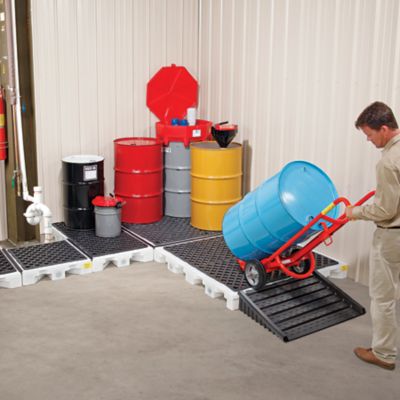Choosing the proper containment product can be difficult, especially with so many options to choose from! Below, we have tried to simplify the decisio

The chemical resistance of polyethylene and steel is often the primary factor when choosing the materials for a containment unit.
Polyethylene is typically preferred when:
- Corrosive or reactive chemicals are stored
- Temperature extremes are not involved
- Corrosion of steel in high-humidity/corrosive environments is a factor
- Dedicated bonding/grounding points are not required
- Cost is a primary concern
Steel is typically preferred when:
- Dedicated bonding/grounding points are required
- Solvents, fuels, and polyethylene-degrading liquids are stored
- Temperature extremes are involved
- High-humidity/corrosive environments are not a factor
Storing flammables and combustibles
Deciding how to store flammable or combustible liquids often presents a unique dilemma. Flammable liquid storage and handling is a highly-regulated subject, yet there is little guidance offered on using, or not using, polyethylene spill containment devices for flammables and combustibles.
When polyethylene is compatible with a flammable or combustible liquid, what other factors must be carefully analysed?
- Is there adequate ventilation to avoid the build up of ignitable ambient vapours?
- What is the fire or heat resistance of the containment device?
- Can control of static accumulation/discharge be made through bonding and grounding?
- What is the proximity of the containment device to heat or ignition sources?
- Are there regulations regarding collection and storage of flammables that apply?
- What are the requirements of the property insurer regarding storage of flammable liquids?
Given the risks involved with handling and storage of flammable or combustible liquids, a small investment of time spent from the outset consulting with knowledgeable parties could avoid major regulatory headaches and the possibility of fire or an explosion within your facility.
What’s the difference between a pallet and a deck?
Spill containment pallets are stand-alone sumps capable of supporting one to eight 210-litre drums, and have the ability to retain the entire contents of a 210-litre drum should the drum fail. Spill Pallets are typically preferred when:
- The number of containers stored per unit is limited to 8 or less
- Regulations require the sump to hold 110% (or more) of the largest container or 25% of the total volume of liquid being stored, whichever is greater
- Storage space is limited
- The containers are not loaded/unloaded frequently
If the spill containment pallet must be moved while the containers are fully loaded, carefully consider the design of the spill pallet and how the weight will be supported during the move, especially if the unit is not made of steel. For polyethylene pallets:
Choose a standard-duty pallet when:
- The unit will not be moved while loaded
- Liquids do not have a high specific gravity
- Liquids are stored in steel drums
Choose a heavy-duty, high-weight rated pallet when:
- The pallet could need to be moved while loaded
- Liquids on the pallet have a high specific gravity, such as acids or caustics
- Liquids are stored in plastic drums
- Various sized containers are being stored
When the spill pallet must be mobile or hold high-load forces, the slightly increased cost of a heavy-duty, high-weight rated spill pallet will prove to be a worthy investment.
Modular spill decks are connectable sumps capable of individually supporting from one to four 210-litre drums. These units have the ability to be linked together to provide spill containment for a multitude of 210-litre drums. They can also be used independently to capture nuisance leaks and spills if full containment is not desired or necessary. Modular spill decks are typically preferred when:
- Space is available for linking multiple units together to achieve regulation-required sump capacity
- The number of containers stored is eight or more
- The unit does not need to be portable
- Low-profile is desired for drum-top accessibility or frequent loading/unloading
- A single device is used for “housekeeping” purposes rather than “containment”
Do you require security or protection from the elements in outdoor use?
When drums must be stored outdoors on a spill containment unit, security of the containers and the prevention of rainwater accumulation or other precipitation in the sump are two factors to consider. In addition, the means of protection must not interfere with access to the containers for visual inspections and should not hamper the workers who will access the drums for pumping or waste collection purposes. PIG Roll-Top Hardcovers are the ideal solution for outdoor drum storage that still allows easy access. Most are also lockable for further security.
Ramps, lifters and accessories
Loading and unloading drums from a spill containment unit is easily accomplished when forklifts and drum lifting attachments are readily available and can move into the storage area with ease. When a forklift lacks a drum lifting attachment and/or space is not available for forklift operation, other safe means of lifting and moving the drums must be employed.
Several types of devices are available for loading or unloading spill containment products, including:
- Ramps for drum trucks
- Drum lifters built to be used as forklift attachments or with overhead cranes
The main considerations for these devices are the weight ratings of both the lifters and ramps, the width and the length of the ramps.
Several types of accessories are also available for spill containment units, allowing a great deal of flexibility for current and future use. Accessory examples include:
- Pumps are available to safely and efficiently pump the accumulated liquids from a sump.
- Horizontal dispensing racks are useful when the sump is used as a dispensing station for horizontal drums. Units are available for both poly and steel pallets, as well as decks. Consider that the rack must be physically compatible with the grating surface of the spill containment unit and also support the expected drum weight.
- Today’s modern spill containment units offer a range of uses and flexibility which can be tailored to suit virtually any need, indoors or outdoors. Careful planning prior to making a selection will help ensure that the containment device provides years of protection of the environment and efficient, convenient service for your employees.
Find out more:
New Pig provide a comprehensive range of spill containment products from our online shop. Or why not give us a call on 0800 919 900.






COMMENTS